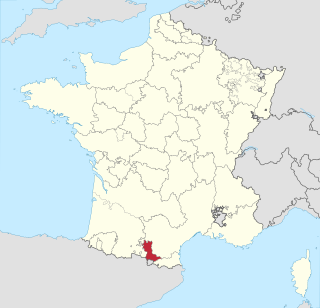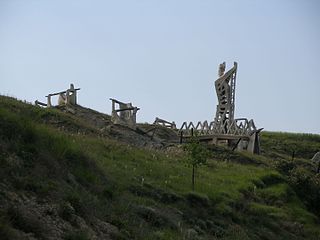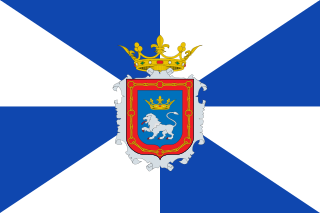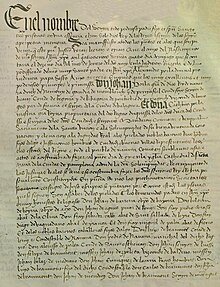
Henry II, nicknamed Sangüesino because he was born in Sangüesa, was the King of Navarre from 1517. The kingdom had been reduced to a small territory north of the Pyrenees mountains by the Spanish conquest of 1512. Henry succeeded his mother, Queen Catherine, upon her death. His father was her husband and co-ruler, King John III, who died in 1516.

Lower Navarre is a traditional region of the present-day French département of Pyrénées-Atlantiques. It corresponds to the northernmost region of the Kingdom of Navarre during the Middle Ages. After the Spanish conquest of Iberian Navarre (1512–24), this merindad was restored to the rule of the native king, Henry II. Its capitals were Saint-Jean-Pied-de-Port and Saint-Palais. In the extreme north there was the little sovereign Principality of Bidache, with an area of 1,284 km2 (496 sq mi) and a decreasing population of 44,450, 25,356.

The Kingdom of Navarre, originally the Kingdom of Pamplona occupied lands on both sides of the western Pyrenees, with its northernmost areas originally reaching the Atlantic Ocean, between present-day Spain and France.

The County of Foix was a medieval fief in southern France, and later a province of France, whose territory corresponded roughly the eastern part of the modern département of Ariège.

The Count of Foix ruled the County of Foix, in what is now Southern France, during the Middle Ages. The House of Foix eventually extended its power across the Pyrenees mountain range, joining the House of Bearn and moving their court to Pau in Béarn. Count Francis Phoebus became King of Navarre in 1479. The last count was King Henry III of Navarre, after whose accession to the French throne the county entered the French royal domain.

Francis Phoebus was King of Navarre (1479–1483), Viscount of Bearn, and Count of Foix (1472). He was the son of Gaston, Prince of Viana, and grandson of Queen Eleanor, whom he succeeded. She recommended him to ally with France.

Catherine was Queen of Navarre from 1483 until 1517. She was also Duchess of Gandia, Montblanc, and Peñafiel, Countess of Foix, Bigorre, and Ribagorza, and Viscountess of Béarn.

Eleanor of Navarre,, was a Navarrese princess and monarch. She served as the regent of Navarre from 1455 to 1479, during the absence of her father, and then briefly as the queen regnant of Navarre in 1479. She was crowned on 28 January 1479 in Tudela.

Madeleine of France, also called Magdalena of Valois, was a French princess who became Princess of Viana by marriage to Gaston of Foix. She was the regent of Navarre between 1479 and 1494 during the minority of her two children, each of whom became monarchs of Navarre: Francis I and Catherine I.

Gaston IV was the sovereign Viscount of Béarn and the Count of Foix and Bigorre in France from 1436 to 1472. He also held the viscounties of Marsan, Castelbon, Nébouzan, Villemeur and Lautrec and was, by virtue of the county of Foix, co-prince of Andorra. From 1447 he was also Viscount of Narbonne. Through his marriage to Eleanor, heiress of the Kingdom of Navarre, he also held the title of Prince of Navarre.

The Battle of Noáin or the Battle of Esquiroz, fought on 30 June 1521 was the only open field battle in the Spanish conquest of Iberian Navarre. It was a decisive victory for the Spanish against the Franco-Navarrese army.

The viscounts of Béarn were the rulers of the viscounty of Béarn, located in the Pyrenees mountains and in the plain at their feet, in southwest France. Along with the three Basque provinces of Soule, Lower Navarre, and Labourd, as well as small parts of Gascony, it forms the current département of Pyrénées-Atlantiques (64).

The Viscounty, later Principalityof Béarn, was a medieval lordship in the far south of France, part of the Duchy of Gascony from the late ninth century. In 1347, the viscount declared Béarn an independent principality without feudal obligations. It later entered a personal union with the Kingdom of Navarre in 1479 and with France in 1589. In 1620, the prince formally incorporated Béarn as a province of France.

The Spanish conquest of the Iberian part of Navarre was initiated by Ferdinand II of Aragon and completed by his grandson and successor Charles V in a series of military campaigns lasting from 1512 to 1524. Ferdinand was both the king of Aragon and regent of Castile in 1512. When Pope Julius II declared a Holy League against France in late 1511, Navarre attempted to remain neutral. Ferdinand used this as an excuse to attack Navarre, conquering it while its potential protector, France, was beset by England, Venice, and Ferdinand's own Italian armies.

Charlotte of Albret, Dame de Châlus, was a wealthy French noblewoman of the Albret family. She was the sister of King John III of Navarre and the wife of the widely notorious Cesare Borgia, whom she married in 1499. She was the mother of his only legitimate child, Louise Borgia, to whom she acted as regent of the Duchy of Valentinois from 1507 to 1514, following the death of Cesare.
Agnes of Navarre was the daughter of Philip III of Navarre and Joan II of Navarre, and became Countess of Foix on marriage to Gaston III, Count of Foix. She was rumoured to have had an affair with poet Guillaume de Machaut and so inspired his poem Le Voir Dit.
Anne d'Albret of Navarre, called Infanta Ana, was a princess of Navarre. She was the heir to the throne of Navarre in 1492-1496 and 1496–1501. She acted as regent of Navarre for her brother Henry II of Navarre several times between 1517 and 1532.

The history of Pamplona as a city goes back to the 1st millennium B.C. when a settlement of Vascones named Iruña existed. However, traces of human occupation of the area date back 75,000 years. In the Roman era, the Vascones settlement was converted into a Roman city by General Pompey, who began by setting up a military camp there in 74 B.C., which he named Pompelo.
Lancelot of Navarre, also called Lanzarot, was an illegitimate son of King Charles III of Navarre who became vicar general and apostolic administrator of the Diocese of Pamplona and the titular Latin patriarch of Alexandria.

















